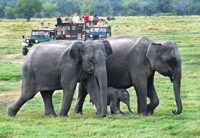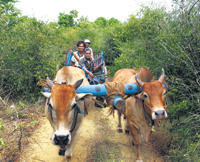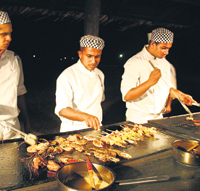|
|
|||||
|
Scenic way to see the simple things in life
An up-close and personal encounter with the wild bunch, a scenic ride through the village on the best four-legged transportation around, walking through a chena cultivation, helping fishermen cast their nets at dawn, a scrumptious barbeque by the lake…many Lankans may consider such things as mere tourist attractions. But how many of us can actually say we’ve taken the time off to experience the simpler things in life that we’ve long since taken for granted? We’re all eager to travel abroad to see the many wonders of the world, but what about the wonders here in our own little world?
That’s where Nature Odyssey (a sister company of Walkers Tours of the John Keells Group) has taken it upon themselves to offer all their clients (local or foreign), a truly “timeless experience”! Our date with Nature Odyssey was at Chaaya Village, Habarana and we were greeted by a troop of monkeys as we turned into the driveway, followed by a more official welcome by the pleasant hotel staff. After a quick coffee it was off to a picnic breakfast in the forest! As we piled in to the van at the starting point of the trek, we had with us a mix of snake, bird, butterfly and elephant men! Quite a ‘wild’ bunch you could say! Trekking through the peaceful village to the shady grove which was our picnic spot, I never realised how much better food tasted when had outdoors. It seemed almost as if time just stood still and nothing else in the world mattered. After breakfast it was straight on alongside the river bank to the chena cultivation where farmers were hard at work. The watch hut beckoned and with the kind help of two of the wild bunch I made my way up the ladder.
Our ride back to the main road where our vehicle was waiting, turned out to be quite a surprise! As we came out from within the last stretch of brush, there were four bullocks, munching lazily nearby. After we climbed aboard the cart, the bullocks took off with the greatest of ease at quite a healthy pace on the bumpy gravel path ahead. Initially ducking under stray branches in our way, we soon discovered an easier, rather picturesque way of both avoiding the branches and enjoying the countryside. We just lay on our backs staring up at the bright blue sky, taking in all nature’s wonders.
Later that day, it was off to the Minneriya National Park to interact with the majestic beasts of the wild. We entered the park with the naturalists relating countless tales of past close calls with elephants and how there were two elephants in particular at Minneriya we were told to watch out for…Kanehila and Waligekota! We were told that the former cow elephant’s calf had been knocked down by a vehicle two years back and therefore, she would more often than not attack a vehicle if agitated. (This is apparently a well known fact amongst all jeep drivers and trackers of the area). The first group of elephants we came face to face with (quite literally) was in fact Kanehila and her ‘gang’! We joined two other jeeps that were parked and watching the elephants, when without any warning the jeep in front of us revved the engine and sped off within inches of Kanehila. Obviously agitated, she gave chase, but stopped halfway and returned all hot and bothered to her herd. Within seconds the other jeep took off, agitating her further, leaving us behind. Having nobody else to vent her anger on, she turned towards us. No matter how hard our team tried to stop her (including our fearless driver) she walked right up to the jeep and head butted it! (I had already envisioned my funeral arrangements at this point…) However, the wealth of experience among the group in the jeep, somehow, steered us out of harm’s way.
Soon after the adrenaline-pumping incident, one of the naturalists pointed towards the water hole saying, “Look at the painted storks!” We all burst out laughing almost hysterically at his desperate attempt to distract us. But the sight was simply breathtaking! A tad weary but hardly tired of reliving our little adventure, we arrived back at the hotel only to be received with a wet towel and the most refreshing drink I have tasted in my life. Ambarella juice that gives life to a weary safari goer! Later that night fire torches paved our path to a sizzling barbeque by the lake, with the cool breeze in our faces and a sing-song to work up an appetite. Having literally ‘sung (together with the energetic team) for our supper’ we then sat down to a relaxed meal around the table, hearing more stories that left us dreaming of elephants, snakes and crocodiles! The next morning we were put up at the crack of dawn to join the fishermen draw in their nets. Usually, you also get the chance to join them in casting their nets on the previous evening. Paddling along in our little oruwa it was quite a scenic sight to behold, with lotuses floating on either side, elephants walking along the opposite bank and villagers busy with their daily chores. Having drawn in the nets, we returned to the shore to an outdoor breakfast of kola-kande and jaggery, followed by a gala breakfast buffet of course! As all good things must come to an end, we too had to part company and go our own way. A full stomach, five new friends and a wealth of memories later…I realised that it had been ‘a timeless experience’ indeed…
| |||||
Copyright © 2006 Wijeya Newspapers
Ltd. All rights reserved. |



